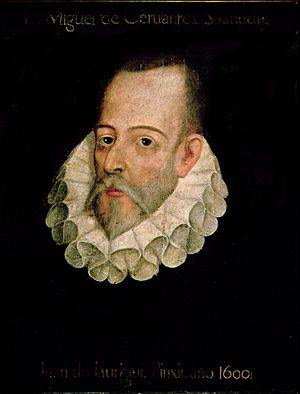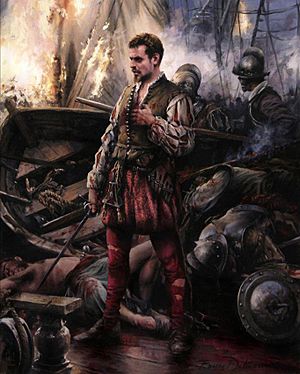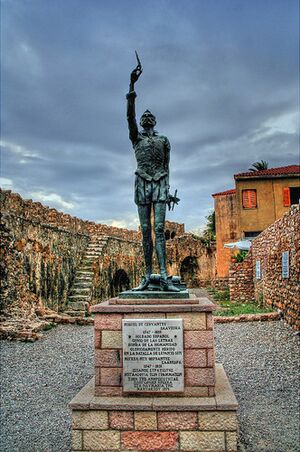Miguel de Cervantes facts for kids
Quick facts for kids
Miguel de Cervantes
|
|
|---|---|

This portrait, attributed to Juan de Jáuregui, is unauthenticated. No authenticated image of Cervantes exists.
|
|
| Born | September 29, 1547 (assumed) Alcalá de Henares, Crown of Castile |
| Died | April 22, 1616 (aged 68) Madrid, Crown of Castile |
| Resting place | Convent of the Barefoot Trinitarians, Madrid |
| Occupation | Soldier, tax collector, accountant, purchasing agent for Navy (Writing was a vocation which did not produce much income.) |
| Language | Spanish |
| Notable works | Don Quixote Entremeses Novelas ejemplares |
| Spouse | Catalina de Salazar y Palacios |
| Children | Isabel c. 1584 (illegitimate) |
| Signature | |
 |
|
Miguel de Cervantes Saavedra (born around September 29, 1547 – died April 22, 1616) is known as the greatest Spanish writer ever. He wrote many novels, poems, and plays. Cervantes is most famous for his novel Don Quixote. This story is about a man who believes he is a knight going on exciting adventures.
Contents
Life of Miguel de Cervantes
Early Years and Family Life
Miguel de Cervantes was born around September 29, 1547. His hometown was Alcalá de Henares, a city near Madrid, Spain. He was the second son of Rodrigo de Cervantes, who was a barber and surgeon. His mother was Leonor de Cortinas.
Miguel's father often struggled to find work. Because of this, Miguel's family moved a lot during his childhood. His mother, Leonor, often supported the family. It is believed that Cervantes went to a Jesuit school in Seville.
Military Service and Capture

In 1566, Cervantes and his family moved to Madrid. In 1569, he had to leave Spain and went to Rome. There, he worked for a cardinal named Giulio Antonio Acquaviva.
In 1570, Miguel joined the Spanish Navy. He was badly hurt in a big sea battle called the Battle of Lepanto in October 1571. Cervantes was shot three times: twice in the chest, and once in his left arm. This injury made his left arm useless. People later called him "El Manco de Lepanto," which means "The one-handed man of Lepanto."
He served as a soldier until 1575. That year, he and his brother Rodrigo left Naples to go back home. But as their ship got close to Barcelona, Ottoman pirates captured it. The brothers were taken to Algiers to be sold as slaves. The pirates thought they could get more money if they held the brothers for ransom. Rodrigo was set free in 1577 after his ransom was paid. After nearly five years and four tries to escape, Cervantes was finally freed in 1580. A religious group called the Trinitarians helped pay for his freedom. They specialized in freeing Christian captives. Cervantes then returned to Madrid.
Later Life and Death
Not much is known about Cervantes' life between 1580 and 1587. In 1587, he got a job as a government agent who bought supplies. Later, in 1592, he became a tax collector. He was put in jail a few times for small problems with his work, but he was always quickly released. He tried several times to get jobs in Spanish America, but he was always turned down. So, he had to stay in Spain.
From 1596 to 1600, he mostly lived in Seville. In 1606, he moved back to Madrid. He stayed there for the rest of his life. Cervantes died on April 22, 1616. He passed away from diabetes. He was buried in the Convent of the Barefoot Trinitarians in central Madrid.
Miguel de Cervantes' Writings

Cervantes said he wrote over 20 plays. One of them, El trato de Argel, was based on his time as a captive. In 1585, he published La Galatea. This was a romantic story set in the countryside, but it was not very popular.
In 1605, Cervantes published the first part of his most famous novel, Don Quixote. He wrote a few more books between the two parts of Don Quixote. The second part of Don Quixote came out in 1615. The Don Quixote series was meant to be different from the "silly and empty" chivalric romance stories of the time. The first part was more of a comedy and was very popular. The second part was seen as more complex and philosophical. Don Quixote is about an old man who loves old stories of brave knights. He loves them so much that he goes on his own adventures. He gets lost in a fantasy world, but he becomes clear-headed near the end. One of the most famous parts is when he fights a windmill, thinking it is a giant!
Don Quixote has been translated into all major languages. There are 700 different editions of the book. Mexican writer Carlos Fuentes said that Cervantes and William Shakespeare are among the greatest writers ever. He put them with authors like Homer, Dante, Defoe, Dickens, Balzac, and Joyce.
In 1905, people celebrated 300 years since Don Quixote was published. In 2016, on the 400th anniversary of his death, a celebration of his plays called Cervantina took place in Madrid. The Miguel de Cervantes Virtual Library is named after him. It is the biggest digital archive of Spanish-language historical and literary works in the world. The popular musical play Man of La Mancha from 1965 was based on Don Quixote.
Places and Shows Named After Cervantes
Places
- Cervantes. This is a town in the province of Lugo, Galicia, Spain. However, the town's name is not based on Miguel de Cervantes. There is no proof he or his family were connected to this town.
- Cervantes. This is a town in the province of Ilocos Sur, Philippines.
- Cervantes. This is a town north of Perth in Australia.
Television Shows
- Cervantes is a character in the Spanish TV show El ministerio del tiempo. Actor Pere Ponce plays him.
- Cervantes had a big part in the episode "Gentlemen of Spain" of the TV series Sir Francis Drake (1961–1962). Actor Nigel Davenport played him. In the story, Cervantes bravely saved other Christian captives from pirates.
Famous Quotes by Miguel de Cervantes
- "Tell me what company you keep, and I'll tell you what you are."
- "Proverbs are short sayings drawn from long experience."
- "Time ripens all things. No man is born wise."
- "There is no greater folly in the world than for a man to despair."
- "He who loses wealth loses much; he who loses a friend loses more; but he that loses his courage loses all."
Fun Facts About Miguel de Cervantes
- His true appearance is still a mystery. All paintings of him are based on his own description of himself when he was 60 years old.
- Miguel came from a wealthy family, but they lost their money. So, he grew up poor.
- In 1613, William Shakespeare wrote a play called The History of Cardenio. It was based on a character from Don Quixote.
- He was removed from the Catholic church three times. This was because collecting taxes to pay for wars was seen as a sin.
- Don Quixote did not make Cervantes rich at the time. Authors did not get paid when people bought their books back then.
- Even though people think he wrote as many as 30 plays, only two of them still exist today.
- The Spanish language is sometimes called la lengua de Cervantes ("the language of Cervantes").
- World Book Day is on April 23. This is the day Miguel de Cervantes was buried.
- His coffin was lost during building work in the 1670s. His final resting place was a mystery until 2015.
See also
 In Spanish: Miguel de Cervantes para niños
In Spanish: Miguel de Cervantes para niños
- Casa de Cervantes
- Instituto Cervantes
- Miguel de Cervantes Prize
- Miguel de Cervantes European University
- Miguel de Cervantes Health Care Centre
- Miguel de Cervantes Liceum
- Miguel de Cervantes Memorial
- Miguel de Cervantes University


